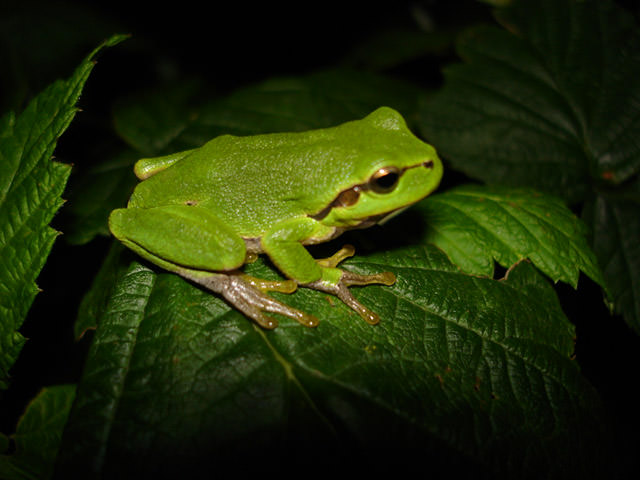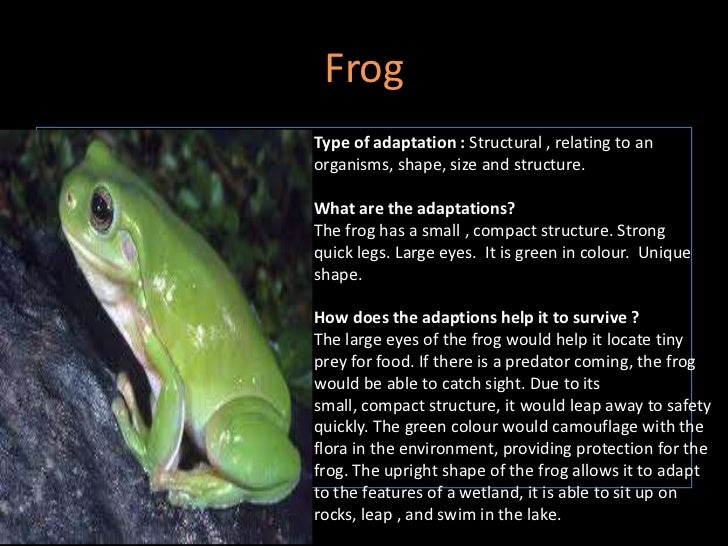
Here is a list of the top ten physical adaptations that enable frogs to thrive in wetlands. Frog adaptations such as a small waist no neck and a broad flat skull make his body streamlined for swimming.

The frogs skin is thin which allows for air to pass through in effect allowing him to breathe through his skin.
Frogs species and their adaptations. What Are The Adaptations Of A Frog. Frogs have many adaptations that help them survive. They have bulging eyes and strong legs to help them with hunting swimming and climbing and their skin may be brightly colored or camouflaged.
What are some frog adaptations. Frog adaptations such as a small waist no neck and a broad flat skull make his body streamlined for swimming. Frog adaptations include specialized legs feet skin eyes and body shape.
Frogs primarily live in water so many of their adaptations enhance their ability to live effectively in an aquatic environment. Frogs have long and powerful legs that allow them to. Frog adaptations in body shape and habitat allow frogs to be successful living in both water and on land.
Frogs are born as tadpoles and the frog characteristics emerge as they grow. Frogs have the ability to breathe air and survive on land but they also need water in which to lay their eggs. Frogs are especially adapted for the places they live in and their colouring is often dependent on their habitat.
Many different species that live in the same types of habitats have similar colourings that helps them to hide from potential predators. Frogs have many adaptations that help them survive. They have bulging eyes and strong legs to help them with hunting swimming and climbing and their skin may be brightly colored or camouflaged.
The TREE FROG has sticky pads on the tips of the fingers and toes. These pads help it stick to plants and trees. The tree frog changes its color to the color of its surroundings.
This is the way a tree frog hides. Some species of tree frogs the chorus frog are found in Canada. This frogs call sounds alot like a bird chirping.
Some species of frog have adaptations that allow them to survive in oxygen deficient water. The Titicaca water frog Telmatobius culeus is one such species and has wrinkly skin that increases its surface area to enhance gas exchange. It normally makes no use of its rudimentary lungs but will sometimes raise and lower its body rhythmically while on the lake bed to increase the flow.
In the northern part of its range the wood frog has a major advantage over other frogs. In the spring the land and the frogs body thaw before the icy covering of lakes ponds and rivers. Wood frogs are therefore able to breed before most other frog species.
They lay their eggs primarily in temporary meltwater ponds also known as vernal pools. Frog adaptations such as a small waist no neck and a broad flat skull make his body streamlined for swimming. The frogs skin is thin which allows for air to pass through in effect allowing him to breathe through his skin.
Powerful hind legs and feet allow the frog to jump long distances. Here is a list of the top ten physical adaptations that enable frogs to thrive in wetlands. Frogs have very powerful back legs and webbed feet that help them swim and jump.
Some frogs even use their legs to dig or burrow underground for hibernating. Certain frogs can jump up to 20 times their own body length in a single bound. All animals adapt to survive in the wild and frogs are no exception.
Here is a list of the top ten physical adaptations that enable frogs to thrive in wetlands. Frogs have very powerful back legs and webbed feet that help them swim and jump. Some frogs even use their legs to dig or burrow underground for hibernating.
However prey species also have adaptations that deter predators. For example toads have glands behind their head that release poison when attacked by a predator. The toads poison causes the predator to salivate which may allow the toad to escape.
Other species have adapted to blend in with their natural environments using. Rainforest animals have adapted to their unique living conditions in these regions. Camouflage is the most common adaptation in the rainforest.
Green-eyed tree frogs and leaf-tailed geckos exhibit this trait by blending into the color of the trees bark and escape from the eyes of predators. Adaptations of frogs to survive freezing Jack R. Layne Jrl Richard E.
Lee Jr2 Department of Biology Slippery Rock University Slippery Rock Pennsylvania 16057 USA Department of Zoology Miami University Oxford Ohio 45056 USA ABSTRACT. Five species of frogs from North Anenca survive extensive freezing of their body fluids to. There are over 5000 species of frogs and still counting.
One of the groups include the poison dart frogs that are toxic and have interesting and vibrant color patterns on their bodies. There is another species called green tree frogs that are translucent green in color and if you see their belly down on a piece of glass you can watch the internal organs and the heart of the frog. Frogs and toads are adapted for hopping and leaping by having powerful hind legs that are much longer than their front legs.
How is a frog adapted for jumping. Frogs that spend more time in water have long very strong legs. They use these legs for jumping and swimming long distances mostly to escape from predators or catch prey.
Some frogs also have webbed feet. Adaptations of frogs to survive freezing Jack R. Layne Jr Richard E.
Lee Jr2 Department of Biology Slippery Rock University Slippery Rock Pennsylvania 16057 USA 2 Department of Zoology Miami University Oxford Ohio 45056 USA ABSTRACT. Five species of frogs from North America survive extensive freezing of their body fluids to.